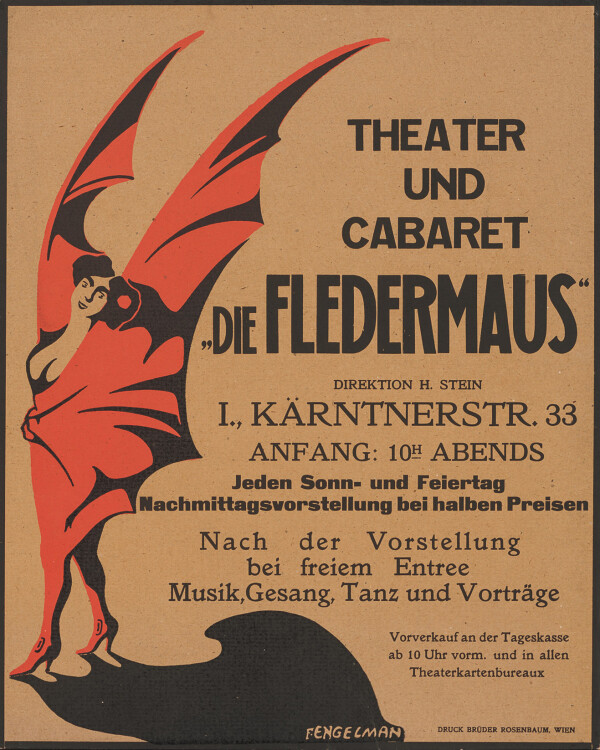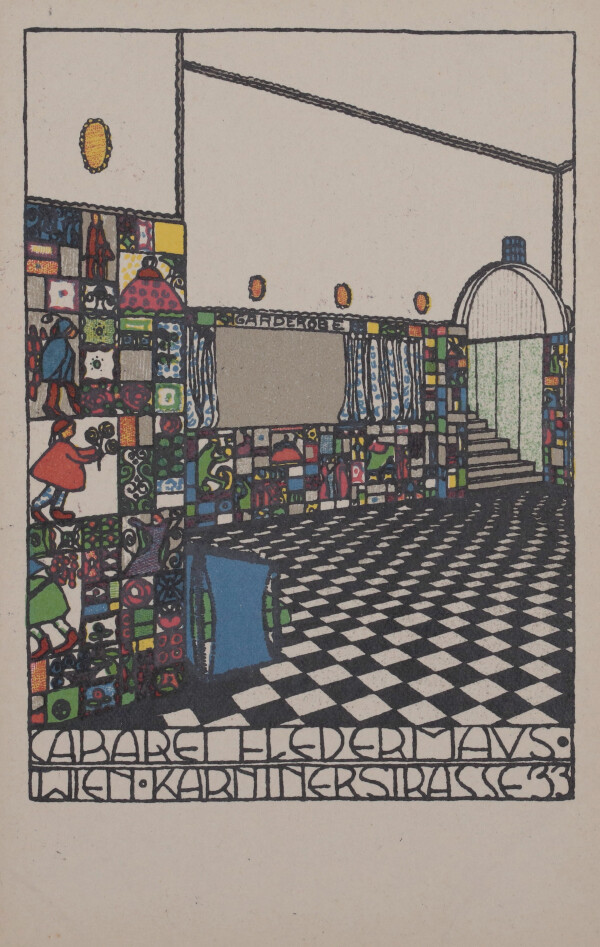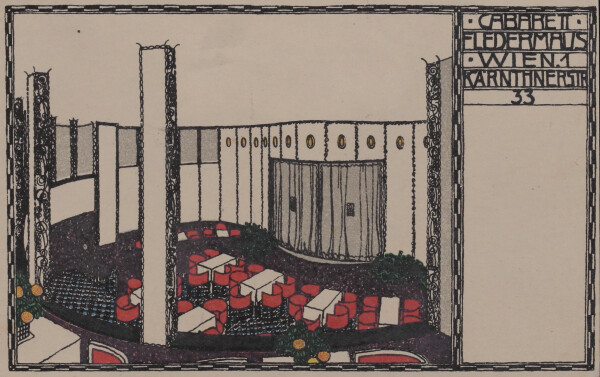Cabaret Fledermaus

F. Engelman: Advertisement for "Die Fledermaus", around 1911
© KHM-Museumsverband

Josef Hoffmann: Postcard "Barroom, Cabaret Fledermaus" by the Wiener Werkstätte, 1907
© Klimt Foundation, Vienna

Josef Hoffmann: Postcard "Cabaret Fledermaus" by the Wiener Werkstätte, 1907
© Klimt Foundation, Vienna

Gustav Klimt: Friends I (The Sisters), 1907, Klimt Foundation
© Klimt Foundation, Vienna
Together with the Stoclet Palace and the Sanatorium Purkersdorf, the entertainment venue Cabaret Fledermaus, designed by Josef Hoffmann in collaboration with numerous artists, ranks among the incunabula of a Gesamtkunstwerk or universal work of art. Klimt regularly visited this place of artistic and experimental freedom and creativity.
Foundation
The Cabaret Fledermaus was situated in the basement of a residential and commercial building (at the corner of Kärntner Straße 33/Johannesgasse 1) in Vienna’s First District, the Inner City). The name for this “theater space for the performing arts” derived from the operetta Die Fledermaus [The Bat] (1874) by Johann Strauss on the one hand and from the eponymous nocturnal animal, a symbol of the hidden and unknown, on the other. The venue borrowed from numerous inspirations, such as the cabaret Le Chat Noir in Paris or the cabaret Die Elf Scharfrichter [The Eleven Headsmen] in Munich. The idea for this Viennese souterrain cabaret had probably conceived by the actor Emil Richter-Roland, who is said to have initially funded its establishment. Very soon, however, Fritz Waerndorfer, a wealthy industrialist and founder of the Wiener Werkstätte, was taken on board as well. The latter also held the position of director until June 1909. Josef Hoffmann was responsible for the concept of this Gesamtkunstwerk.
“In Vienna, cabaret turns ingenious as to arts and crafts”
As is revealed in the programmatic pamphlet of the Fledermaus, its highest priority was to be different from all of Vienna’s other popular nightclubs. It was to offer its audience a broad spectrum of performing arts – from shadow plays and dance to readings and experimental performances. The club’s programmatic manifesto was published by the Wiener Werkstätte. Its author is unknown, but many things suggest that Peter Altenberg penned these lines.
The Cabaret Fledermaus opened on 19 October 1907. The Arbeiterzeitung wrote appreciatively:
“Last night, the Cabaret Fledermaus was unveiled to three hundred chosen ones. What Professor Hoffmann has created here in subterranean Kärntner Straße ranks among his architectural masterpieces. No one else will be able to imitate this genuinely delicious space of his […].”
“First meeting, then Fledermaus”: Klimt’s Visits to the Cabaret
Klimt was among the first three hundred guests present on the opening night. On 14 January 1908 he visited the cabaret a second time, witnessing the dance premiere of the Wiesenthal Sisters – Grete, Elsa, and Bertha – at the Fledermaus together with Hugo von Hofmannsthal, Josef Hoffmann, Bertold Löffler, Kolo Moser, and Otto Wagner, among others. The engagement of the dancing sisters had been made possible by Waerndorfer, who had acted upon Hofmannsthal’s advice. The Wiesenthal ladies’ upcoming performances proved groundbreaking and extremely successful. The following year, Klimt visited the venue in the company of Hermann and Therese Flöge (née Paulick) and further acquaintances on 27 February, and then again in early March, with Ferdinand Bloch, his patron.
Klimt and Art at the Fledermaus
In said program, Gustav Klimt is mentioned as a “decorative” collaborator. To what extent he was directly involved in the conception of the Cabaret Fledermaus is not documented, but there can be no doubt that he had a main share in the formulation of its aesthetic concept. That the cabaret’s interior architecture may have had an impact on Klimt is suggested by the painting Friends I (The Sisters) (1907, Klimt-Foundation, Vienna), which he finished while sojourning on the Attersee in the summer of 1907. In this double portrait, the checkered pattern of the floor recurs as a fragmented ornament, and the colorful dotted pattern near the upper right margin seems to make reference to the polychrome design of the tiles in the bar room. Two elegant ladies dressed in winter costumes resemble female visitors or the dance-minded Wiesenthal sisters.
On the other hand, Klimt’s formal idiom made itself felt in the creations of the artists working for this establishment and of the Wiener Werkstätte respectively. A costume design dedicated to Fritz Waerndorfer for the dancer Miss Olga George by Kolo Moser from 1908 illustrates this mutual inspiration. A wealth of ornament embellished the woman’s physique, reminiscent of the way Klimt articulated himself in his paintings during the period in question, such as in Portrait of Adele Bloch-Bauer I (1907, Neue Galerie New York). Vegetal forms suggesting spirals adorn the dancer’s left underarm. Moreover, the golden-brownish tendril’s of Moser’s pictorial fabric seem to hark back to the forms in Klimt’s work Water Snakes I (Parchment) (1904, reworked before 1907, Belvedere, Vienna).
The “Colored Grotto of Horror” as an Impressive Gesamtkunstwerk
The premises of the cabaret were made up of different sections. From the street, visitors went downstairs to an imposing bar area decorated in polychromy. From there, they would reach a plain theater auditorium featuring white plastered walls and grey marble. The decoration consisted of a raised linear pattern featuring white ornaments in the form of grapes. An intermediate floor furnished with boxes and additional seats could be reached via a stairway. With this gem of Art Nouveau, Hoffmann had created a Gesamtkunstwerk or universal work of art similar to the Stoclet Palace in Brussels or the Sanatorium Purkersdorf. Individual elements, including Hoffmann’s “Fledermaus furniture,” which had been manufactured by the bentwood furniture factory Jacob & Josef Kohn, acquired the status of icons.
Bertold Löffler and Michael Powolny, the founders of the Wiener Keramik earthenware factory, produced some 7,000 colored majolica tiles for the bar in collaboration with a number of artists, most of whom are unknown today. This polychromy was in contrast to the black and white floor tiles. To Ludwig Hevesi, the room appeared like a
“colorful […] grotto of horror, colorful like colorfulness and fantastic like fantasy.”
Further important collaborators were, among others, Eduard Josef Wimmer-Wisgrill and Josef von Divéky for the costume designs and Marya Delvard, Mela Mars, and the Wiesenthal Sisters for the dance. Hermann Bahr, Dr. Franz Blei, and Dr. Hans Heinz Evers contributed as literary collaborators. The painters Oskar Kokoschka and Carl Otto Czeschka also played prominent roles, as did Egon Friedell and Alfred Polgar, who wrote pieces for the cabaret stage.
The Fledermaus’s Downfall
The exorbitant costs involved finally led to Waerndorfer’s and the Wiener Werkstätte’s retreat in June 1909. Hugo Stein from Berlin took over as director. Under his auspices, the multifaceted spectrum of performances was considerably reduced. Parts of the Wiener Werkstätte’s interior were removed and replaced by more inexpensive furnishings. Eventually, the Cabaret Fledermaus was forced to close down for good due to its precarious financial situation: the establishment has thus not survived for posterity.
In 2019, the legendary bar was reconstructed on behalf of the Vienna University of Applied Arts’ Department for Art Collection and Archiving. That same year, it was presented to the public at the Barbican Art Gallery in London and, shortly afterwards, at the Österreichische Galerie Belvedere in Vienna.
Literature and sources
- Ludwig Hevesi: Kabarett Fledermaus, in: Fremden-Blatt, 18.10.1907, S. 12.
- Barbara Lesák: Hundert Jahre Kabarett Fledermaus. Eine Kleinkunstbühne im Kontext der europäischen Theateravantgarde im frühen 20. Jahrhundert, in: Thomas Trabisch, Michael Buhrs, Barbara Lesák (Hg.): Kabarett Fledermaus 1907-1913. Ein Gesamtkunstwerk der Wiener Werkstätte. Literatur, Musik, Tanz, Ausst.-Kat., Museum Villa Stuck (Munich), 18.10.2007–27.01.2008; Theater Museum (Vienna), 18.02.2008–08.06.2008, Vienna 2007, S. 9-15.
- Gerd Pichler: Das Kabarett Fledermaus. Ein Gesamtkunstwerk der Wiener Werkstätte, in: Thomas Trabisch, Michael Buhrs, Barbara Lesák (Hg.): Kabarett Fledermaus 1907-1913. Ein Gesamtkunstwerk der Wiener Werkstätte. Literatur, Musik, Tanz, Ausst.-Kat., Museum Villa Stuck (Munich), 18.10.2007–27.01.2008; Theater Museum (Vienna), 18.02.2008–08.06.2008, Vienna 2007, S. 51-87.
- Herta Neiß: Die wirtschaftlichen Hintergründe des Kabarett Fledermaus, in: Thomas Trabisch, Michael Buhrs, Barbara Lesák (Hg.): Kabarett Fledermaus 1907-1913. Ein Gesamtkunstwerk der Wiener Werkstätte. Literatur, Musik, Tanz, Ausst.-Kat., Museum Villa Stuck (Munich), 18.10.2007–27.01.2008; Theater Museum (Vienna), 18.02.2008–08.06.2008, Vienna 2007, S. 89-97.
- Claudia Feigl: Die Chronologie der »Fledermaus«, in: Thomas Trabisch, Michael Buhrs, Barbara Lesák (Hg.): Kabarett Fledermaus 1907-1913. Ein Gesamtkunstwerk der Wiener Werkstätte. Literatur, Musik, Tanz, Ausst.-Kat., Museum Villa Stuck (Munich), 18.10.2007–27.01.2008; Theater Museum (Vienna), 18.02.2008–08.06.2008, Vienna 2007, S. 89-97.
- Ernst Ploil: Economics, in: Christian Witt-Döring, Janis Staggs (Hg.): Wiener Werkstätte 1903-1932. The Luxury of Beauty, New York 2017, S. 20-31.
- N. N.: Theater und Kunst. Das Cabaret Fledermaus, in: Arbeiter-Zeitung, 20.10.1907, S. 8.
- Ludwig Hevesi: Kabarett Fledermaus, in: Altkunst – Neukunst, Vienna 1909, S. 240-245.
- Ansichtskarte von Gustav Klimt in Wien an Emilie Flöge in Paris, 1. Karte (Morgen) (02/27/1909).
- Ansichtskarte von Gustav Klimt in Wien an Emilie Flöge in Paris, 1. Karte (Morgen) (05.03.1909).
- Alexander Klee: Ein kollektives Gesamtkunstwerk, in: Florence Ostende (Hg.): Into the Night. Die Avantgarde im Nachtcafé, Ausst.-Kat., Barbican Art Gallery (London), 04.10.2019–19.01.2020; Lower Belvedere (Vienna), 14.02.2020–01.06.2020, Munich 2019, S. 56-63.
- Cosima Rainer (Hg.): Kabarett Fledermaus @ Bar du Bois. Aktualisierung eines Experiments der Wiener Moderne, Ausst.-Kat., Heiligenkreuzer Hof (Vienna), 12.03.2020–24.10.2021, Vienna - Berlin - Boston 2021.
- Elana Shapira: Der »andere« Wiener Visionär. Metamorphose im Kabarett Fledermaus, in: Cosima Rainer (Hg.): Kabarett Fledermaus @ Bar du Bois. Aktualisierung eines Experiments der Wiener Moderne, Ausst.-Kat., Heiligenkreuzer Hof (Vienna), 12.03.2020–24.10.2021, Vienna - Berlin - Boston 2021, S. 54-65.

